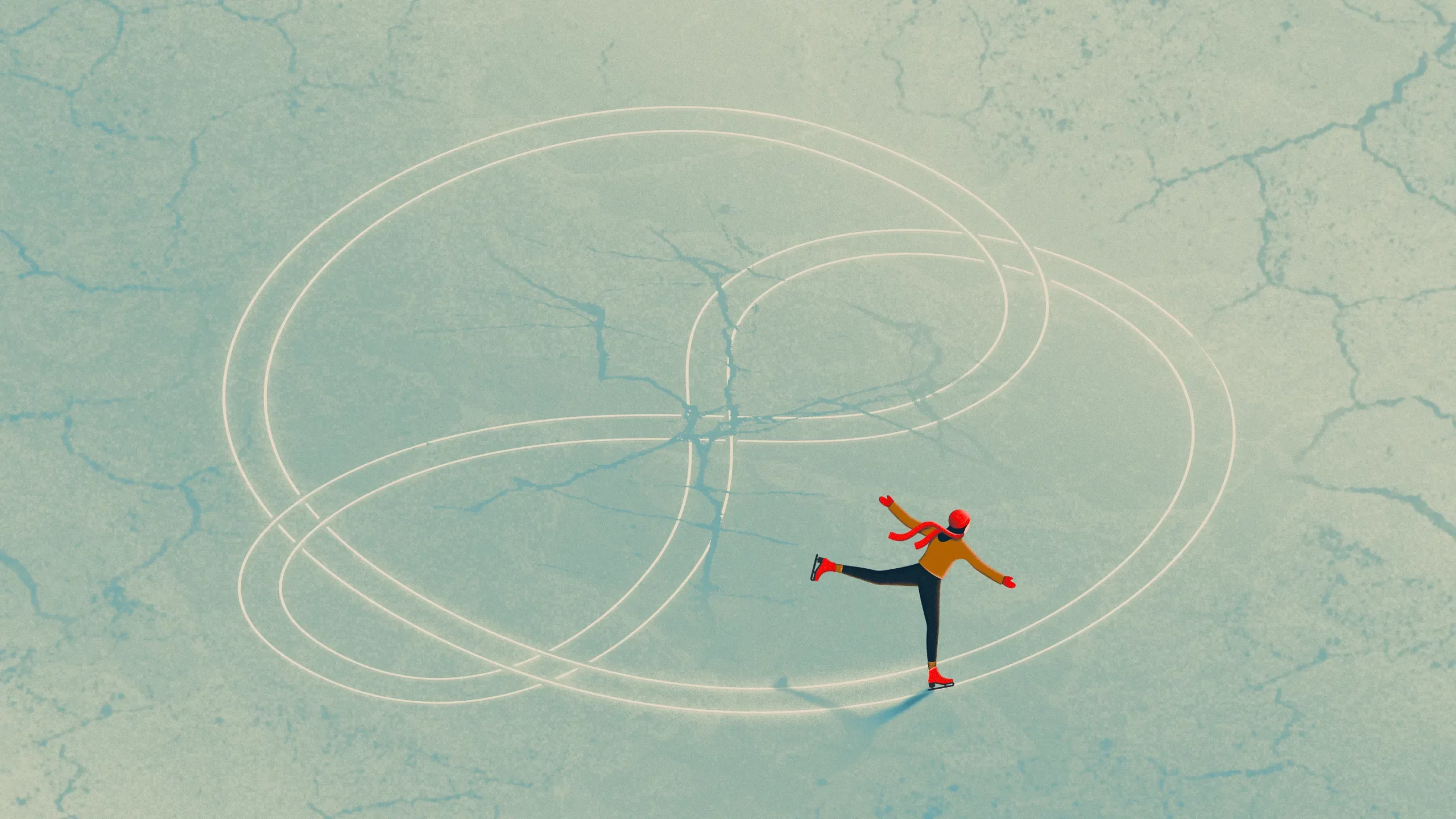Mathematicians Eliminate Long-Standing Threat to Knot Conjecture

Kristina Armitage/Quanta Magazine
Introduction
Over 60 years ago, Ralph Fox posed a problem about knots that haunts mathematicians to this day. His question is now often formulated as the “slice-ribbon conjecture,” which posits that two seemingly distinct groups of knots are actually the same. With its suggestion of elegant simplicity within the world of knots, it’s become one of the most high-profile problems in knot theory. “It would mean that the world is a little bit more structured than you might expect otherwise,” said Arunima Ray, a mathematician at the Max Planck Institute for Mathematics in Bonn.
For decades, one particular knot was suspected to be a possible route to settling the conjecture. Yet in a paper posted last summer, five mathematicians found that this knot isn’t going to work after all. While the arguments they introduced will provide new insights into a broader class of knots, the work as a whole leaves mathematicians uncertain about the conjecture. “I think there’s actual legitimate controversy on whether it’s going to turn out to be true or not,” said Kristen Hendricks, a mathematician at Rutgers University.
The slice-ribbon conjecture concerns two types of knots: slice knots and ribbon knots. Figuring out which knots are slice is “one of the fundamental questions that our subject revolves around,” said Abhishek Mallick, one of the authors of the new paper.
A mathematical knot can be thought of as an ordinary loop of string. Mathematicians call a simple loop without a knot in it the “unknot.” (Though this isn’t a knot in the ordinary sense of the word, mathematicians think of the unknot as the simplest example of a knot.)
Knots also define the boundary of a shape that mathematicians call a disk, even though it doesn’t always look disk-like in the ordinary sense of the word. The simplest example, the unknot, forms the boundary of a circle — a “disk” that does indeed look like a disk. But the loop forms the boundary not only of a circle that lies flat on a table, but also of a bowl — which extends into three dimensions — that’s laid upside down on top of the table. The disks that knots define can be further extended from three dimensions into four.
If there is a knot in the string, the disks get more complicated. In three-dimensional space, those disks have singularities — points where they are mathematically ill-behaved. Slice knots are those for which it’s possible — in four dimensions — to find a disk without such singularities. Slice knots are the “next-best thing to the unknot,” as Peter Teichner, also of the Max Planck Institute, has put it.
Despite that, the disks bounded by slice knots in three dimensions can be ugly and difficult to work with. The slice-ribbon conjecture says they don’t necessarily have to be.
Ribbon knots are knots whose disks resemble ribbons. In three dimensions, these ribbons can pass through themselves, just as an ordinary ribbon can be pulled through a gash made down its center. Mathematically, such a pass-through is called a ribbon singularity. Unlike other types of singularities, the ribbon singularity can be easily eliminated by moving into four dimensions. This makes it easy for mathematicians to show that all ribbon knots are slice.
The converse — that every slice knot is also ribbon — is the slice-ribbon conjecture, which has been an open question for decades. (To complicate matters further, slice knots have several related classifications, including “smoothly slice” and “topologically slice.” The conjecture applies only to the “smoothly slice” kind of knot, which is what mathematicians usually mean by “slice.”)
To disprove the conjecture, it suffices to find a knot that is smoothly slice, but not ribbon. For decades, mathematicians had their eye on a candidate: the (2, 1) cable of the figure-eight knot, made by threading a second string along a figure-eight knot and then merging the two strings to make a single knot.
In 1980, Akio Kawauchi proved that this knot is both rationally and algebraically slice, properties that are similar to being smoothly slice, but not quite the same. In 1994, Katura Miyazaki proved it isn’t ribbon, leaving a suspenseful opening for mathematicians. If Kawauchi’s result could be strengthened just a touch to show that the knot is smoothly slice, it would disprove the conjecture.
The new paper proves that the knot in question is not slice after all, slamming this door shut.
“Slice-ribbon conjecture, still going strong,” said Hendricks, who has worked closely with two of the authors of the new paper. “That’s very exciting, because people have tried to understand this example for quite a long time.”
The new proof is based on something called a branched double cover. You can visualize a branched double cover by thinking of a hollow sphere, like a basketball. To make a branched double cover of a basketball, slice it open from top to bottom along one of the lines of longitude. Now, pull on one side of the rubber where you’ve cut, stretching it along the equator until the material wraps all the way around. Once you’ve finished this transformation, you have a basketball made of two interchangeable layers of material, hence the “double cover.” (In this scenario, the rubber can be stretched and twisted however you like without breaking or crumpling.)
The “branched” in “branched double cover” comes from a quirk of the transformation. Since you stretched horizontally, there’s still only one layer at the very top and bottom points of the ball, the north and south poles. These points are called branch points, and their presence makes the double cover into a branched double cover.
When it comes to knots, the branched double cover is assembled in such a way that the branch points are the knot itself: the points which, like the north and south poles of the basketball, are only covered once.
“Historically, looking at double branched covers has been a standard tool of the trade,” said Jennifer Hom, a mathematician at the Georgia Institute of Technology who has worked with two of the new paper’s authors. This is because — just as a basketball surrounds a ball of air — the branched double cover of a slice knot surrounds a certain four-dimensional shape. If mathematicians can show that a knot’s branched double cover doesn’t surround the right 4D shape, they can rule out the possibility that the knot is slice.
But this doesn’t quite work for the (2, 1) cable of the figure-eight knot: Its branched double cover does surround the right type of four-dimensional shape. Showing that the (2, 1) cable of the figure-eight knot isn’t slice depends on an often overlooked symmetry of the shape.
When you stretch the surface of a basketball to form a branched double cover, you can imagine doing something analogous to the three-dimensional ball of air inside. As you pull the rubber around the ball, just pull the air along with it. Just as the two layers of rubber are interchangeable, there are two hemispheres in the ball of air that both end up in the same place. In other words, the symmetry from the outside of the ball extends to the inside.
In the same way, the symmetries on the branched double cover of a slice knot reach into the 4D space within. Mathematicians usually disregard this symmetry when trying to show that knots are not slice. But in this case, it was essential. If the authors of the new work could show that there was no such symmetry, they’d be able to conclude that the knot isn’t slice.
“Because the question does not refer to any symmetry, you’d think: Well, how does the symmetry come into the picture to say anything about it? But somehow, magically, in this case the symmetry comes to the picture and solves the problem for you,” said Mallick, who authored the new paper with Irving Dai of Stanford University, JungHwan Park of the Korea Advanced Institute of Science and Technology, Matthew Stoffregen of Michigan State University, and Sungkyung Kang of the Institute for Basic Science in South Korea.
“We knew that that structure was there. But part of the reason why people were not studying it is that we had no way of keeping track of that structure,” Ray said. “You need a fancy, high-powered tool in order to detect that.”
To make the argument, the team had to use deep, complicated mathematics related to the knot and its surrounding space, relying on symmetries more subtle even than those of the branched double cover. In two previous papers, Dai, Mallick and Stoffregen had calculated some of these properties. When Kang paid a visit to Stoffregen at Michigan State last summer, the (2, 1) cable of the figure-eight knot still on his mind, the researchers quickly realized that those formulas would settle the problem of its sliceness. “There’s an intuition, which told me that this computation should work,” Kang said. “And by just computing it, we should be able to solve this problem right now.”
In late July, their paper was posted online, proving the knot was not, in fact, slice. The ideas in the paper, Park said, should be applicable to many knots whose sliceness is currently in question. “This is just the beginning,” he said. Though this paper focuses on a particular knot, Park said the tools they developed will work for far more general families of knots. The non-sliceness of the original knot, however, ensures that the slice-ribbon conjecture will remain unsettled for now.



